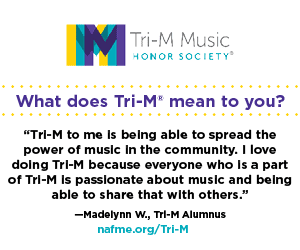/ News Posts / Beginning Bassoon Players: Let Them Play Flat
Beginning Bassoon Players: Let Them Play Flat
By NAfME Member Elizabeth Fetters
Do you mind breaking a few hard and fast band rules for the benefit of your beginning bassoon players?
Let them play flat.
Really? Let them play flat? Yes!
The bassoon is a big instrument, and the player must move a lot of air. Often beginning players, especially young players, do not have the breath support and the core muscles to support the sound. You will especially notice it on C, D, E, E-flat, and F in the bass clef staff. These notes are unstable on the bassoon. Keep encouraging them to “blow,” we can refine the sound later once they’ve mastered the notes and fingerings. Worry if they are playing sharp. A beginning player playing sharp is very serious, because it means there is tension in the embouchure and the student is squeezing the reed.
Let them play their band music down an octave.
Beginning band music is often written with the clarinets, trumpets, saxophones, or trombones in mind. As much as I would love a band full of beginning bassoon players, I understand why beginning band music is structured the way it is. However, beginning trombone players love to play high, and beginning bassoon players love to play low. Allow your bassoon players to play the “Trombone/Bass Clef Baritone/Bassoon” part an octave lower than written for the first six months or so. Notes that venture above the bass clef staff are difficult for beginning bassoon players to play and cause frustration. These notes are very similar to the lower octave in fingering, but require a subtle change in the way the player directs the air stream.
Let them play F major as their first scale.
It’s the easiest scale on the bassoon. If they start on low F (below the bass clef staff), they don’t have to play high notes, and the scale walks right up the front of the bassoon. Plus, they’re still playing B-flat, which they’ll need in their band music.
Let them sit back in their chair.
The bassoon is held in place by a seat strap that goes under the player’s legs. Forcing a student to sit up on the edge of their chair takes away the proper placement of the seat strap. Allow bassoon players to sit up tall, bottom all the way back in the chair. Seat strap goes behind the knees, instrument comes across the body.
Let them out of band two minutes early.
It takes a long time to put the bassoon away. Encourage beginning bassoon players to swab the boot joint and wing joint and carefully put the reed in a safe place. We don’t want them rushing to their next class and damaging an expensive instrument or reed.
About the author:
NAfME member Elizabeth Rusch Fetters received her music education degree from Indiana University of Pennsylvania, her master’s degree in bassoon performance from Kent State University, and her master’s in Library Science from the University of Maryland. She currently teaches middle school vocal and general music for Harford County Public Schools in Maryland. She is a founding member of the Hunt Valley Symphony Orchestra. She is also a freelance musician and soloist in the area. Mrs. Fetters teaches bassoon privately and her students have won chairs in honors ensembles and received excellent ratings at festivals. She has numerous articles published in The Instrumentalist, The Maryland Music Educator, The Double Reed Journal, and the NAfME blog. When she isn’t making reeds, Mrs. Fetters likes to read, cook, and run or cycle on the trail.
Interested in reprinting this article? Please review the reprint guidelines.
The National Association for Music Education (NAfME) provides a number of forums for the sharing of information and opinion, including blogs and postings on our website, articles and columns in our magazines and journals, and postings to our Amplify member portal. Unless specifically noted, the views expressed in these media do not necessarily represent the policy or views of the Association, its officers, or its employees.
Published Date
April 9, 2018
Category
- Ensembles
- Standards
Copyright
April 9, 2018. © National Association for Music Education (NAfME.org)








